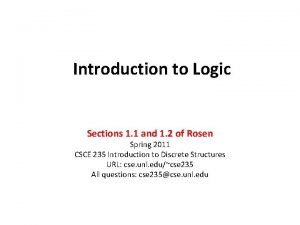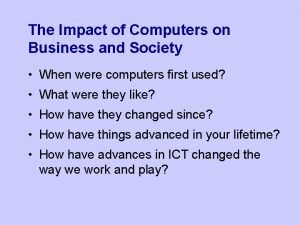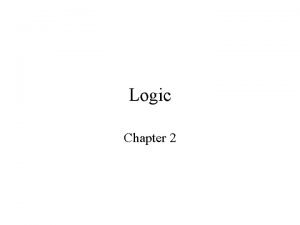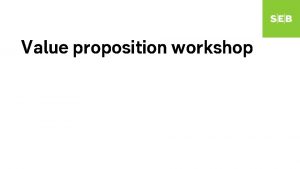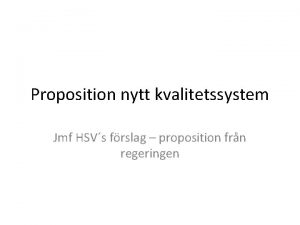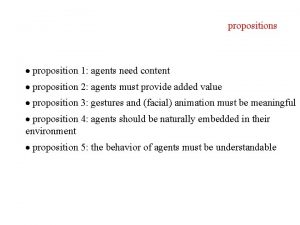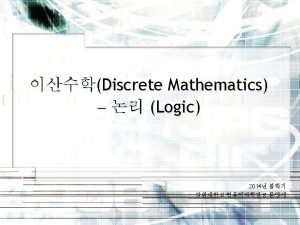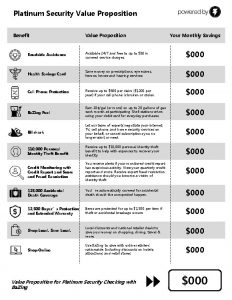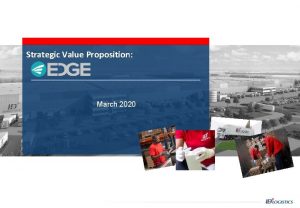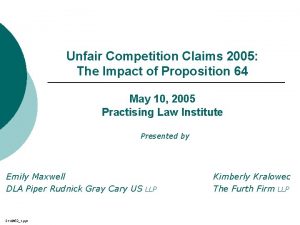From Proposition 13 to Today The impact of

































- Slides: 33

From Proposition 13 to Today- The impact of ballot initiatives, legislation and precedent on the California public education system.

The California Constitution and the Creation of the Public School System “I think that here, above all places in the Union, we should have, and we possess the resources to have, a well regulated system of education. Education, sir, is the foundation, sir, is the foundation of republican institutions; the school system suits the genius and the spirit of our form of government. If the people are to govern themselves, they should be qualified to do it. They must be educated; they must educate their children; they must provide means for the diffusion of knowledge and the progress of enlightened principles. ” -Robert Semple, delegate from Solano county at the first Constitutional Convention of California

Article IX, Section 2 “The Legislature shall encourage, by all suitable means, the promotion of intellectual, scientific, moral and agricultural improvement. The proceeds of all land that may be granted by the United States to this State for the support of schools, which may be sold or disposed of, and the five hundred thousand acres of land granted to the new States, under an act of Congress distributing the proceeds of the public lands among the several States of the Union…shall be inviolably appropriated to the support of common schools throughout the State. ” - Set aside a vast domain of public lands to be sold for the benefit of the public school fund

Article IX, Section 3 The Legislature shall provide for a system of common schools, by which a school be kept up and supported in each district at least three months in every year, and any school neglecting to keep and support such a school, may be deprived of its proportion of the interest of the public fund during such neglect.

• 1851 - The first free public school opened in San Francisco. Within 12 months, the city had seven schools in session with 791 children enrolled. • 1866 - The state mandates uniform textbook series and courses of study. • 1874 - California requires compulsory school attendance for children 8 to 14. • 1911 - The state guarantees aid for local districts based upon the number of children attending school in the district. • 1912 - Textbooks become free. • 1921 - Local school boards are given the task of setting their own budgets and taxes.

Serrano v. Priest I - 1971 Facts: Plaintiffs, Los Angeles County public school children and their parents, brought a class action for declaratory and injunctive relief against certain state and county officials charged with administering the financing of the California public school system, on the basis that the way California schools are funded causes substantial disparities among individual school districts in the amount of revenue available per pupil for the districts' educational programs. Issue: Whether the California public school financing system, with its substantial dependence on local property taxes and resultant wide disparities in school revenue, violates the equal protection clause of the Fourteenth Amendment? Holding: Yes, the public school financing system in California invidiously discriminates against the poor and violates the equal protection clause of the Fourteenth Amendment. The source of revenue, local property taxes, causes substantial disparities among individual school districts in amount of revenue available per pupil for the districts' educational grants.

“We have determined that this funding scheme invidiously discriminates against the poor because it makes the quality of a child's education a function of the wealth of his parents and neighbors. Recognizing as we must that the right to an education in our public schools is a fundamental interest which cannot be conditioned on wealth, we can discern no compelling state purpose necessitating the present method of financing. We have concluded, therefore, that such a system cannot withstand constitutional challenge and must fall before the equal protection clause. ”

San Antonio Independent School District v. Rodriquez- 1973 Facts: Class action brought on behalf of school children, who were said to be members of poor families residing in school districts having a low property tax base, challenging reliance by Texas school-financing system on local property taxation. Issue: Whether a public school system that is substantially financed by local property taxes, and thus has wide disparities depending on the value of the property in the district, violates the equal protection clause of the Fourteenth Amendment? Holding: No. Education is not a fundamental right guaranteed by the US Constitution. Thus, this is not an instance in which it would be appropriate to apply the equal protection clause strict judicial scrutiny test. Since the state was able to show that the disparities in public education funding bore a rational relationship to a legitimate state purpose, the funding system does not violate the equal protection clause of the Fourteenth Amendment.

Serrano v. Priest II- 1976 Reaffirmed Serrano I. The CA Supreme Court clarified that they had based their decision in Serrano I upon the federal AND the state constitution. And whereas the US Constitution does not explicitly guarantee a right of education, as recognized by the Supreme Court in Rodriquez, the CA Constitution does. Wealth-related disparities in per-pupil expenditures for general purposes should be equalized and the difference in amount spent per pupil should not exceed $100. (Adjusted for inflation, the difference in amount spent per pupil in 2011 should not exceed $350)

“For these reasons then, we now adhere to our determinations, made in Serrano I…. [I]n light of our state constitutional provisions guaranteeing equal protection of the laws (1) discrimination in educational opportunity on the basis of district wealth involves a suspect classification, and (2) education is a fundamental interest. Because the school financing system here in question has been shown by substantial and convincing evidence produced at trial to involve a suspect classification…and because that classification affects the fundamental interest of the students of this state in education, we have no difficulty in concluding today, as we concluded in Serrano I, that the school financing system before us must be examined under our state constitutional provisions with that strict and searching scrutiny appropriate to such a case. ”

Serrano v. Priest III- 1977 -Reaffirmed Serrano I & II. - Included a six-year timetable for bringing the funding system into compliance with the Court’s ruling in Serrano.

Senate Bill 90 - 1972 Imposed a ceiling on the amount that any district could receive from the county for education purposes per number of students enrolled in the district. The ceiling was to be adjusted for inflation so that high-wealth districts received a lower inflation factor than low-wealth districts, with the goal of making revenue limits across districts more equal over time. Meant to equalize the amount that the school districts spent per student. Ultimately, as the Court ruled in Serrano II, SB 90 did little to cure the inequities in public school funding.

Assembly Bill 65 - 1977 Legislative response to Serrano decisions Created a minimum “base” amount for education per pupil. Required counties to transfer a certain percentage of their revenue designated for school funding (generated from property taxes) to the state. The state then allocated a certain amount back to the school districts based upon the number of students attending school in that district. The state calculated the dollar amount that each district was expected to contribute to the schools per student based upon the total property value in the district and the number of pupils enrolled. If combined revenues from the state and the district fell short of the “base” amount the district was to spend per student, then the state would make up the difference in “equalization aid. ”

District’s Contribution Based on Property Tax Revenue: Example Low Income District High Income District “Base” amount per pupil in 1977: $1, 132 Basic aid from the state: $125 District’s expected share: $450 State equalization aid: $557 Total from the state: $682 “Base” amount per pupil in 1977: $1, 132 Basic aid from the state: $125 District’s expected share: $1, 007 State equalization aid: $0 Total from the state: $125

Persisting Inequities under AB 65 Counties with higher property taxes and more valuable homes generated more revenue from property taxes, but were not forced to transfer a larger percentage of it to the State School Fund. These wealthier counties were permitted to keep their additional property tax revenue and, if they chose, to use it to increase funding for their school districts.

Proposition 13 - 1978 “Section 1. (a) The maximum amount of any ad valorem tax on real property shall not exceed one percent (1%) of the full cash value of such property. The one percent (1%) tax to be collected by the counties and apportioned according to law to the districts within the counties. ” Based property taxes on the property’s 1975 value and restricted annual increases of assessed value of real property to an inflation factor, not to exceed 2% per year. Prohibited reassessment of a new base year value except for (a) change in ownership or (b) completion of new construction.

Prop 13 – Property Tax Revenue Then and Now Before Property values were regularly reassessed and property taxes were based upon the property’s value that year. Property taxes varied by county. Property value in 1978: $10, 000 Tax rate of 2%: $200 Property value in 1980: $20, 000 Tax rate of 2%: $400 After Property value not to increase more than 2% each year, regardless of actual value, as long as the property does not change hands. Property tax 1%. Property value in 1975: $8, 000 Tax rate of 1%: $80 Property value in 1980: $20, 000 Tax rate of 1%: $88. 32

Consequences of Prop 13 In 1979, the revenue generated from California property taxes was less than half than the year before Although the total property value per pupil in a district had not changed, the districts could no longer generate their expected share of school funding per pupil. Without state aid, districts would have fallen 25 -30 percent short of their expected share. To compensate for the loss caused by the decreased property tax revenue, the state was forced to contribute a much larger percentage to school districts.

Assembly Bill 8 - 1979 The state’s response to Prop 13 and the district’s inability to contribute their “expected share. ” Under AB 8, approximately 60% of school funding comes the state (business and personal income taxes, sales taxes, and some special taxes), less than 23% comes from local property taxes, 6% from local revenue (like parcel taxes), and about 2% comes from the California Lottery. Retained Revenue Limits- wealthier districts who spend more on education due to larger property tax revenues are allowed to increase their yearly spending per pupil at a lower level than districts who spend less. Attempt to adhere to Serrano decisions and equalize spending between districts. Shifted much of the remaining property tax revenues to other local government services, while the state supplemented the school districts budget with revenues from the state general fund.

- In 1978, when Prop 13 passed, California was ranked 14 th in the nation in per pupil spending. In 2010, California was ranked 44 th.

Changes in Funding- Property Tax v. General State Fund Since the passage of Prop 13, the amount of money spent per pupil in California has not kept pace with inflation and cost of living. Before Prop 13, the revenue available to fund schools increased whenever property values increased, which was generally at a rate similar to inflation. After Prop 13, the state struggled to increase per pupil spending at the same rate as inflation. Because the majority of school funding now comes from income, business and sales tax, the amount of money available to fund schools for a particular year is highly dependent upon the state of the economy. Whereas the revenue generated from property tax was somewhat stable, now the source of funding for schools is highly inconsistent.

Where CA Stands in Relation to the Rest of the Nation Today

Proposition 98 - 1988 Response to decreased spending, a depleted state budget and a tough economy Requires a minimum percentage of the state budget to be spent on K 14 education. Guarantees an annual spending increase in education in the California budget to keep pace with per capita growth and increased student enrollment. Three different levels of funding determined by the strength of the economy.

-In 1988, Prop 98 mandated that 39% of the state’s budget was to be spent on K-14 education. In subsequent years spending on education was to equal the previous year’s spending, plus, at minimum, increases for per capita growth and increased student enrollment. -However, in 2011, only 27. 6% of the state’s budget was spent on K-14 education.

Why? Prop 111 - reduced the school financial aid requirements if certain fiscal stresses existed at the state level. In particular, in no- or low-revenue growth years, the state was allowed to modify the Prop 98 formula through a complex series of adjustments. Prop 98 has acted more like a ceiling than a floor- the intent of Prop 98 was to insure that schools would receive minimum funding in tough economic years, and in years of growth would receive at least the same amount as the year before PLUS increases for inflation and per capita growth. Instead, the state funds schools at the minimum level each year without these built in increases. The result is that the percentage of the state budget spent on schools has actually decreased, rather than increased.

The Aftermath School districts are now passive recipients of state revenues Streamlined curriculums Standardized testing Teaching to the test Limited curriculums, basic skills emphasis, course consolidations, eliminating the arts and vocational training programs

California’s Public Schools Accountability Act of 1999 (SB X 1) Authorized the Superintendent of Public Instruction and the State Board of Education to construct a metric to measure the performance of schools, comprised primarily of the results of standardized state tests. Requires schools to meet a minimum growth target of 5% against a statewide target set by the Superintendent of Public Instruction and the State Board of Education. Until the budget crisis in California, schools that met their growth targets in the second and third years of the program were eligible for financial incentives; schools that did not meet their growth targets were identified as under-performing and targeted for intervention.

How CA Compares: National Assessment of Educational Progress California ranks: 47 th for fourth-grade reading 45 th for fourth-grade math 49 th for eighth-grade reading 48 th for eighth -grade math …. in the nation.

Persisting Inconsistencies in Funding by District (from National Center of Education Statistics) TOP 5 TOTAL FUNDING District Revenue Limit Funding Total Funding Enrollme nt Mt Pleasant Elementary $5, 470. 00 $28, 754. 00 2, 963 Woodside Elementary $10, 592. 00 $17, 307. 00 458 Portola Valley Elementary $11, 118. 00 $16, 077. 00 737 Emery Unified $7, 246. 00 $15, 541. 00 783 Acalanes Union High $6, 788. 00 $15, 360. 00 5, 714

Highest v. Lowest Districts BOTTOM 5 TOTAL FUNDING District Revenue Limit Funding Total Funding Enrollme nt Brentwood Union Elementary $5, 504. 00 $7, 703. 00 8, 247 Union Elementary $5, 729. 00 $7, 730. 00 4, 576 Byron Union Elementary $5, 546. 00 $7, 769. 00 1, 671 Evergreen Elementary $5, 425. 00 $7, 787. 00 13, 380 Walnut Creek Elementary $5, 434. 00 $7, 895. 00 3, 236

Williams v. State of CA Assertions by Plaintiffs: The state as a whole is responsible for addressing basic inequities in education ; State policies on the key issues in the case—access to qualified teachers, up-to-date textbooks, and adequate and safe facilities—had been insufficient at best and at worse had exacerbated inequalities. The state was aware of the inequities in its educational system—much of the documentation for the lawsuit was drawn from state data and reports and newspaper articles. Given these conditions, plaintiff’s argued that by focusing exclusively on test scores, the accountability system generated in the wake of the PSAA was “indifferent to gross disparities in the opportunities and conditions for learning provided by the State’s system of education to students in different schools and school districts. ” Settled by Governor Schwarzengger in 2004. The settlement includes almost $1 billion in funding for low-performing schools, to be directed toward providing students in those schools with highly qualified teachers, standards-aligned instructional materials, and safe and adequate facilities.

Teacher’s credentials and experience Facilities Access to technology, textbooks and other materials Percentage of ELS students in the district 25% v. 9% nationally Student-teacher ratio CA ranked last in the nation Student background variables (mobility, percentage receiving free lunches, limited English speakers)

There still exist ways for counties to override revenue limits and to spend excess property tax revenue on schools. Schools with a larger share of students from more affluent families are able to fill budget gaps by raising dollars from private donations. A survey of California high school principals conducted by the University of California, Los Angeles (UCLA) compared schools with less than 34 percent of students from low-income families, to schools with at least 63 percent of students from low-income families. The survey found that low-poverty schools received an average of $100, 000 in private donations compared to $5, 000 in donations received by high-poverty schools. The UCLA survey also found that low-poverty high schools were more likely than high poverty high schools to require students and families to pay for or make additional contributions to school services. By shifting costs to students and families, lowpoverty schools can maintain services that many high-poverty schools cannot, which contributes to widening inequality among schools.
 Implication law
Implication law Impact of computer in business
Impact of computer in business Fingerprint ridge characteristics worksheet
Fingerprint ridge characteristics worksheet For today's meeting
For today's meeting Today's lesson or today lesson
Today's lesson or today lesson Do we have class today
Do we have class today Today's lesson or today lesson
Today's lesson or today lesson Proposal kickoff meeting agenda
Proposal kickoff meeting agenda Sơ đồ cơ thể người
Sơ đồ cơ thể người ưu thế lai là gì
ưu thế lai là gì Tư thế ngồi viết
Tư thế ngồi viết đặc điểm cơ thể của người tối cổ
đặc điểm cơ thể của người tối cổ Cái miệng xinh xinh thế chỉ nói điều hay thôi
Cái miệng xinh xinh thế chỉ nói điều hay thôi Hình ảnh bộ gõ cơ thể búng tay
Hình ảnh bộ gõ cơ thể búng tay Cách giải mật thư tọa độ
Cách giải mật thư tọa độ Tư thế ngồi viết
Tư thế ngồi viết Voi kéo gỗ như thế nào
Voi kéo gỗ như thế nào Thẻ vin
Thẻ vin Thể thơ truyền thống
Thể thơ truyền thống Các châu lục và đại dương trên thế giới
Các châu lục và đại dương trên thế giới Từ ngữ thể hiện lòng nhân hậu
Từ ngữ thể hiện lòng nhân hậu Diễn thế sinh thái là
Diễn thế sinh thái là Frameset trong html5
Frameset trong html5 Thế nào là giọng cùng tên?
Thế nào là giọng cùng tên? Vẽ hình chiếu vuông góc của vật thể sau
Vẽ hình chiếu vuông góc của vật thể sau Phép trừ bù
Phép trừ bù Hươu thường đẻ mỗi lứa mấy con
Hươu thường đẻ mỗi lứa mấy con Lời thề hippocrates
Lời thề hippocrates Thang điểm glasgow
Thang điểm glasgow đại từ thay thế
đại từ thay thế Quá trình desamine hóa có thể tạo ra
Quá trình desamine hóa có thể tạo ra Công thức tiính động năng
Công thức tiính động năng Thế nào là mạng điện lắp đặt kiểu nổi
Thế nào là mạng điện lắp đặt kiểu nổi Dot
Dot
